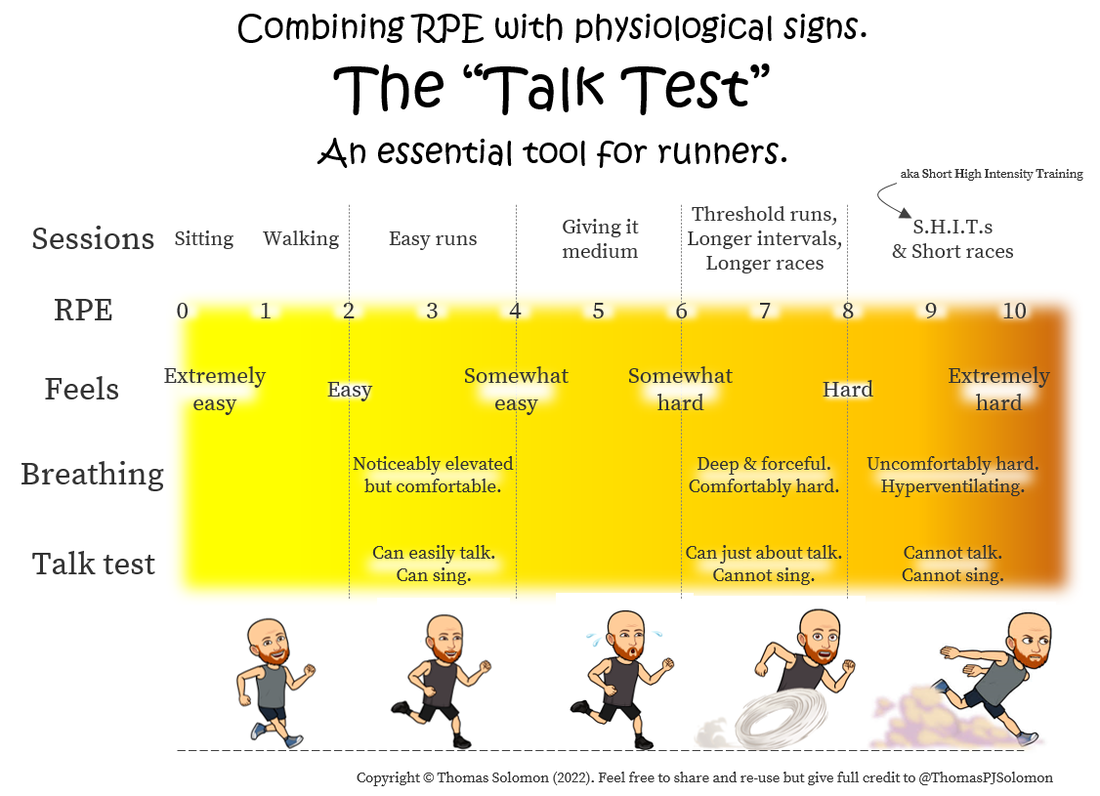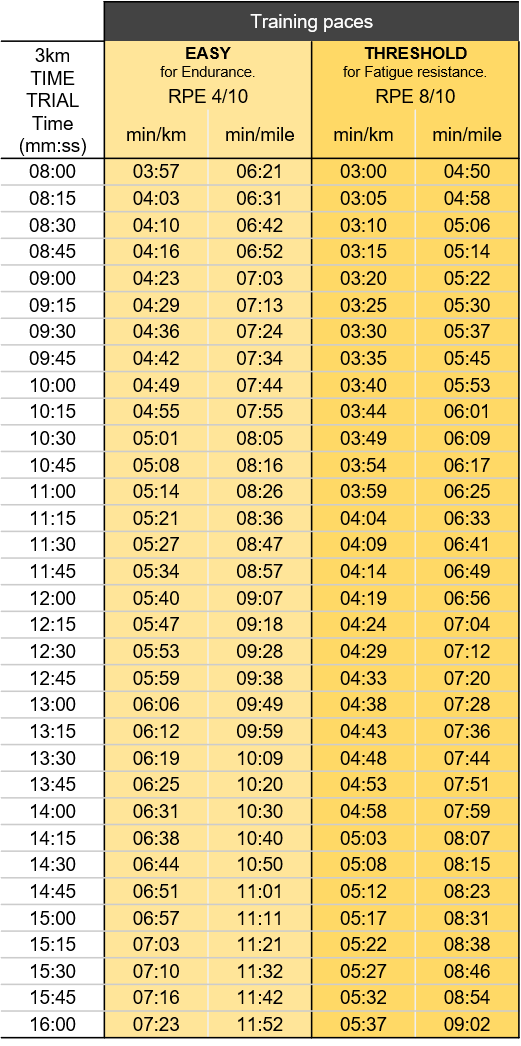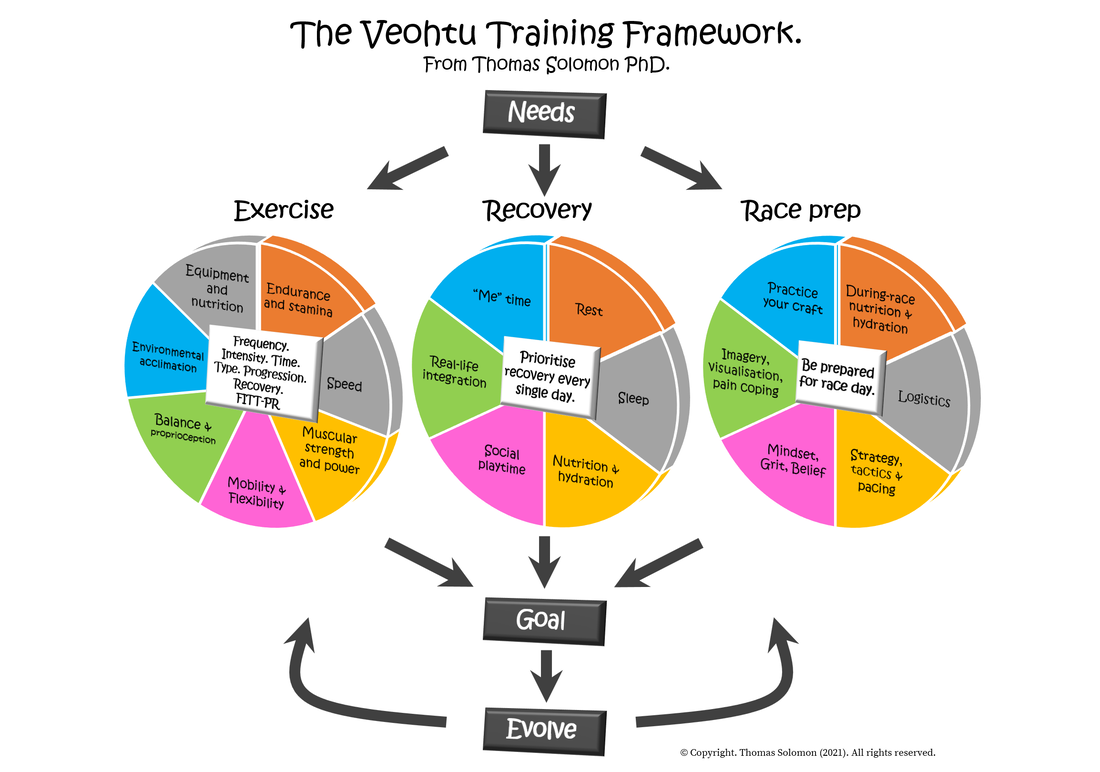Free trail running and mountain running training plan
Run. Sometimes hard. Rest. Repeat.
Boost your fitness, improve your race times, and learn how to train smart, run fast, and be strong.
A structured, periodized, scientific, and educational exercise training plan.
For trail running and mountain running newbies with a background of running.
Informed by experimental and empirical evidence.
Designed by me, Thomas Solomon PhD.


Fitness tests
Before you join this training plan for the first time, please complete the following fitness test to help ensure you are working at the right intensities during the sessions. Fitness test weeks recur during the plan to see how you're progressing and to re-calibrate your training intensities. If you're re-joining the plan after a break (due to illness, injury, or apathy), please repeat the tests.
Start with Run Warm-up (see suggestion here), then:
Race 3 km as fast as you can. I.e., run 7.5 laps of a 400-metre running track, or find a flat and uninterrupted route using Mapmyrun, or set a 3 km distance function on your GPS watch.
Compare your finish time against the pacing table (see chart here) to see what your training paces should be.
Finish with 5 mins of EASY running followed by Cool-down exercises (see suggestion here).
NOTE: Warm-up and cool-down exercises are described in a section further down this page (click here).
Once you have completed the time-trial fitness test, you are ready to rock!
The training plan below is structured around two 6-month macrocycles each containing three 4-week mesocycles, and each mesocycle contains two higher-load "stress" weeks followed by a "deload" week and a low-load "recovery" week:
 Macrocycle 1: Base-phase (Dec to Feb), Transition-phase (Mar and Apr), Race-phase (May and Jun).
Macrocycle 1: Base-phase (Dec to Feb), Transition-phase (Mar and Apr), Race-phase (May and Jun).
 Macrocycle 2: Base-phase (Jul), Transition-phase (Aug), Race-phase (Sept and Oct). November is a "rest phase".
Macrocycle 2: Base-phase (Jul), Transition-phase (Aug), Race-phase (Sept and Oct). November is a "rest phase".

What do you need?
(click the buttons)
(click the buttons)
If you like this content, please help me build an audience by sharing this page with your people. This will help the magical algorithms promote my content higher up the rankings so that more folks see it.
Rating of Perceived Exertion (RPE), Breathing rate, and the Talk test — how hard should you train?
Learn to be aware of your feelings, your breathing rate, and your ability to talk/sing, and set your training intensities according to your Rating of Perceived Exertion (RPE) out of 10, where RPE 1/10 is being sat down doing nothing and RPE 10/10 is maximal. Study the diagram below to learn what level of exertion to give for the various training intensities.

Please feel free to use and share this image but give credit to Thomas Solomon PhD.
Use the following guidelines to maximise your long-term gains for endurance racing:
 80% to 95% of your weekly running time should be spent in the "Easy" domain at RPE 2-4/10. Increase your weekly volume by gradually increasing the weekly number of Easy runs and gradually increasing their duration. This will help condition your body to move faster for longer during your harder runs. Any hiking, running, riding, etc, that you add on top of the prescribed training should be kept in the "Easy" intensity domain at RPE 2-4/10.
80% to 95% of your weekly running time should be spent in the "Easy" domain at RPE 2-4/10. Increase your weekly volume by gradually increasing the weekly number of Easy runs and gradually increasing their duration. This will help condition your body to move faster for longer during your harder runs. Any hiking, running, riding, etc, that you add on top of the prescribed training should be kept in the "Easy" intensity domain at RPE 2-4/10.
 Only 5% to 20% of your weekly running time should be spent doing "Hard" work, at or above RPE 6/10. These types of sessions are taxing, add a lot of strain to your body, and take longer to recover from. Sure, training hard every day will acutely increase your fitness, but it will also increase your risk of injury and accumulate excessive fatigue, making subsequent sessions feel harder and leaving you needing more time to recover from them. Don't aim to be mighty tomorrow; play the long game and be sensible. Train smart.
Only 5% to 20% of your weekly running time should be spent doing "Hard" work, at or above RPE 6/10. These types of sessions are taxing, add a lot of strain to your body, and take longer to recover from. Sure, training hard every day will acutely increase your fitness, but it will also increase your risk of injury and accumulate excessive fatigue, making subsequent sessions feel harder and leaving you needing more time to recover from them. Don't aim to be mighty tomorrow; play the long game and be sensible. Train smart.
If you like this content, please help me build an audience by sharing this page with your people. This will help the magical algorithms promote my content higher up the rankings so that more folks see it.
Running pace chart — how fast should you run?
When you have completed the 3 km Time Trial, find your finishing time in the first column of the chart below, then read across the row to find out what paces you should aim to run during your "Easy" and "Threshold" sessions when running on Flat terrain.
 IMPORTANT: When doing uphill efforts or running on hilly/mountainous terrain, these estimated "flat terrain" paces are useless and should not be used as targets. In such circumstances, ignore pace and use the RPE scale along with the Breathing and Talk test descriptions to work at the correct level of exertion (click here).
IMPORTANT: When doing uphill efforts or running on hilly/mountainous terrain, these estimated "flat terrain" paces are useless and should not be used as targets. In such circumstances, ignore pace and use the RPE scale along with the Breathing and Talk test descriptions to work at the correct level of exertion (click here).
 When going up steep inclines on an "Easy" run, it is very likely that you will have to lower your pace to a hike in order to keep the intensity low. That is totally fine! Even Jon Albon, Kilian Jornet, Lindsay Webster, and Courtney Dauwalter hike when the grade gets steep.
When going up steep inclines on an "Easy" run, it is very likely that you will have to lower your pace to a hike in order to keep the intensity low. That is totally fine! Even Jon Albon, Kilian Jornet, Lindsay Webster, and Courtney Dauwalter hike when the grade gets steep.
Why run at different paces?
= totally comfortable, really slow jogging (or hiking on challenging terrain) that slightly increases your heart rate and breathing rate.
You could sustain this level of effort for several hours, without fatigue.
You could sustain this level of effort for several hours, without fatigue.
= a comfortably hard effort that induces a highly noticeable increase in heart rate and breathing rate after a few minutes of running, where you are right on the edge of fatigue.
This is the kind of pace you could sustain for 30 to 40 minutes but, if you went any faster, you would fatigue quickly.
This is the kind of pace you could sustain for 30 to 40 minutes but, if you went any faster, you would fatigue quickly.
= an uncomfortably hard effort that induces a high heart rate and breathing rate and makes you hyperventilate.
There is no pace assigned to S.H.I.T. sessions, but it is the kind of speed you can only sustain for a short time (e.g. just a few seconds if you are sprinting, or a few minutes if you are running at your 1-mile race pace).
There is no pace assigned to S.H.I.T. sessions, but it is the kind of speed you can only sustain for a short time (e.g. just a few seconds if you are sprinting, or a few minutes if you are running at your 1-mile race pace).

Please feel free to use and share this image but give credit to Thomas Solomon PhD.
If you like this content, please help me build an audience by sharing this page with your people. This will help the magical algorithms promote my content higher up the rankings so that more folks see it.
Circuits and Skimo sessions for obstacle course racers.
(clickable links to instructional videos)
Circuit exercises:
Squat ¦
Forward lunge (alternating legs) ¦
Wall sit ¦
Step-up ¦
Glute bridge ¦
Hip hinge ¦
Standing calf-raise ¦
Seated calf raise ¦
Lying knee raise ¦
Ab walk out ¦
Side plank ¦
Wrist to knee crunch ¦
Plank ¦
Russian twist ¦
Superman ¦
Alternating bird dog ¦
Bench dip. ¦
Incline push-up ¦
Pike press ¦
Inverted row (high bar) ¦
Underhand inverted row (High bar) ¦
Plank ¦
Hollow-hold ¦
L-sit ¦
Wall sit
Skimo exercises:
If you like this content, please help me build an audience by sharing this page with your people. This will help the magical algorithms promote my content higher up the rankings so that more folks see it.
Warm-up and cool-down for running.
(clickable links to videos)
WARM-UP
Complete 5 reps of each exercise at a low intensity (RPE 2/10) using a full range of motion, and move on to the next exercise.
Rocking frog. ¦ Alternating cossack squats. ¦ Walking knee hugs.. ¦ Walking ankle grabs. ¦ Walking squats. ¦ Walking lunges. ¦ Walking leg-swings. ¦ Lateral leg swings.
Start with 2 minutes Brisk walking with purpose, no harder than RPE 2/10.
Then 2 minutes of Easy-paced jogging, no harder than RPE 4/10.
Then 2 minutes of running, progressing up to Threshold, no harder than RPE 8/10.
Complete 2 x (5-secs, 15-sec rest) of each exercise at a moderate- to vigorous intensity (RPE 6-8/10).
Butt-kicks. ¦ High-knees. ¦ High-knee skips.
Run up to 6 x 10-second accelerations, with 1 min rest between each.
Accelerate to ~95% of maximal speed (not an all-out sprint).
Focus on running tall, looking forward, and being light on your feet with a fast foot turnover.
Warm-up complete. You are ready to rock!
COOL-DOWN
If you like this content, please help me build an audience by sharing this page with your people. This will help the magical algorithms promote my content higher up the rankings so that more folks see it.
Warm-up and cool-down for circuits and skimo sessions.
(clickable links to videos)
WARM-UP
Complete 10-reps of each exercise at a low-intensity (RPE 2/10), and move on to the next exercise.
Rocking frog. ¦ Lying hip abduction. ¦ Lying hip adduction ¦ Lying hip internal rotation ¦ Lying hip external rotation ¦ Walking knee hugs.. ¦ Walking ankle grabs. ¦ Walking squats. ¦ Resistance band shoulder rotations. ¦ Resistance band pull-aparts. ¦ Scapular pull-ups.
2-mins Super Easy (RPE 2/10)
2-mins Easy (RPE 4/10)
2-min progression up to Threshold (RPE 8/10).
NOTE: If you plan to do an Easy run on a Circuit day, integrate it into your Circuit session warm-up and cool-down.
Warm-up complete. You are ready to rock!
COOL-DOWN
Think critically. Keep informed. Stay educated.
To help empower yourself to train smart, join the 100s of other people who subscribe to my free educational content and receive free summaries of the latest evidence in exercise and nutrition science:
I will not bombard your inbox with product offers and pointless messages — I hate spam as much as you do! Subscribing to my mailing list gives you first-access to my articles and nerd alert summaries of the latest in running-related exercise and nutrition science. The content is free and designed to help you train smart.


